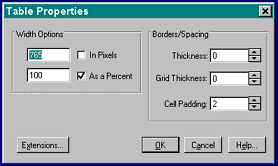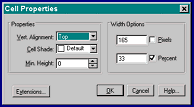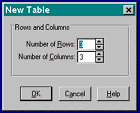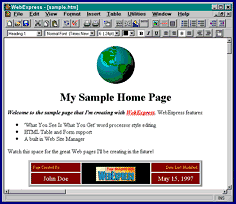Tables: Positioning Text & Images | |||||||||||||||||||||||||||||||||||||||||||||||||||||||||||||||||||||||||||||||||
This section will explain fundementals of what HTML Tables are, then start you on the road to creating your own using the superb WebExpress Table editing tools. If you're already familiar with Table basics, you may wish to skip directly to the section Adding A Table To Your Web Page. An Overview Of HTML Tables HTML Tables allow you to be more precise when you position images and text on your Web page.
A sample Table appears below:
Unlike the text and images you've entered into paragraphs thus far, the paragraphs, images, or other HTML elements within each Table Cell are treated independently by a browser. For example, the Table below illustrates how paragraphs in each Cell are positioned independently next to one another on the page, rather than in a single vertical series of paragraphs:
Note also how the paragraphs in the Cells above are each aligned differently. Since Table Cells are independently rendered on the screen, the WebExpress Alignment Buttons (like Center, Left, and Right Align) affect only the paragraph in a particular Cell.
Controlling Table Appearance:
Note how the height of this Table is slightly less than the height of the Table above it. Remember that what a Cell contains determines the height of the Cell, and the height of all Cells in a Column determines the height of the Table as a whole. In addition to controlling Table and Cell width and height, you can also control the Table Border Size (or leave the border invisible), you can control the amount of Spacing between the contents of Table Cells and their border, and you can specify how Cell contents are Vertically Aligned within the Cell. You can even change the Background Color of individual Table Cells. Nesting Tables: One of the most powerful features of the HTML Table is its ability to be Nested within another Table. Nesting a Table means that you can create an independent Table within a Cell of an existing Table. For example, all of the Tables shown on this page thus far are actually Nested within a larger Table that contains the Row and Column information. In reproducing the first Table on this page below, we've made the outer Table's border visible so you can see it:
As you can see, HTML Tables enable you to enhance your Web page design considerably. Now we'll show you how easy it is to create and edit Tables using WebExpress! Adding A Table To Your Web Page Now we're going to add a simple HTML Table to your sample Web page. While these instructions may seem a little longer that other sections of the tutorial, keep in mind that creating Tables is really a straightforward process and will soon become second nature to you. The results are well worth the effort! Here is the Table as it will appear when we're finished (we'll stick to wild colors for now!):
Step 1: To prepare a place for the Table, move the cursor to the end of the last text paragraph on your page, the paragraph that says "Watch this space for the great Web pages I'll be creating in the near future!". Press the 'Enter' key to create a blank line, now click the Center Alignment Button on the toolbar. The cursor should now be blinking on a centered blank line on your page.
| |||||||||||||||||||||||||||||||||||||||||||||||||||||||||||||||||||||||||||||||||
Step 2: Now we'll adjust the width of the Table, in addition to setting a few other properties that will make the Table appear like we want it to.

| |||||||||||||||||||||||||||||||||||||||||||||||||||||||||||||||||||||||||||||||||
| |||||||||||||||||||||||||||||||||||||||||||||||||||||||||||||||||||||||||||||||||
|
|||||||||||||||||||||||||||||||||||||||||||||||||||||||||||||||||||||||||||||||||
Step 3: Next we need to adjust the width, alignment, and color of the Table Cells. The properties of each Cell can be set individually, but we can also change the properties of several Cells at once by first highlighting the Cells we want to change. | |||||||||||||||||||||||||||||||||||||||||||||||||||||||||||||||||||||||||||||||||
|
|
||||||||||||||||||||||||||||||||||||||||||||||||||||||||||||||||||||||||||||||||
 |
| ||||||||||||||||||||||||||||||||||||||||||||||||||||||||||||||||||||||||||||||||
Phew! Did it go okay? Good! Now highlight the two Cells in the center of your Table. We're first going to Span the center Cells across the two Rows and change them to a single Cell.
While the new single Cell is still highlighted, select 'Table' then 'Cell Properties' again from the Menu, and enter the following settings for it in the Cell Properties Window:
|
|||||||||||||||||||||||||||||||||||||||||||||||||||||||||||||||||||||||||||||||||
| |||||||||||||||||||||||||||||||||||||||||||||||||||||||||||||||||||||||||||||||||
Assignment: Finish up by entering the content into the Table, as it appears in the finished example above, on your own. If you're not sure enough of yourself yet to do so, just follow the steps below:
| |||||||||||||||||||||||||||||||||||||||||||||||||||||||||||||||||||||||||||||||||
Congratulations! You've made it through the longest part of the tutorial... Working with HTML Tables will become easier with experience. It's well worth the effort, however, for all that Tables will add to your Web page's appearance and functionality. For example, in this tutorial all of the content for each page is written in one table consisting of three Columns of Cells. Experiment as much as you need to.
| |||||||||||||||||||||||||||||||||||||||||||||||||||||||||||||||||||||||||||||||||


 From
the WebExpress Menu, click on 'Table' then 'Insert Table'.
From
the WebExpress Menu, click on 'Table' then 'Insert Table'. Your Web Page should now appear as shown at right:
Your Web Page should now appear as shown at right: